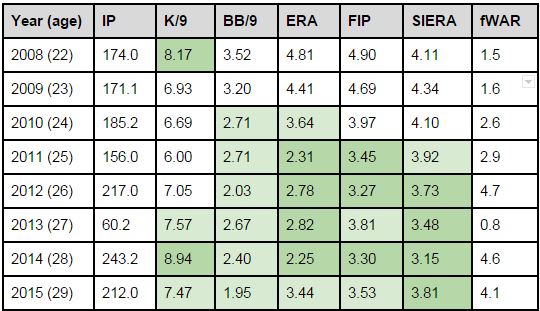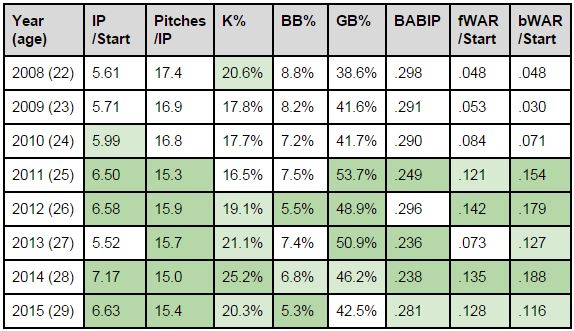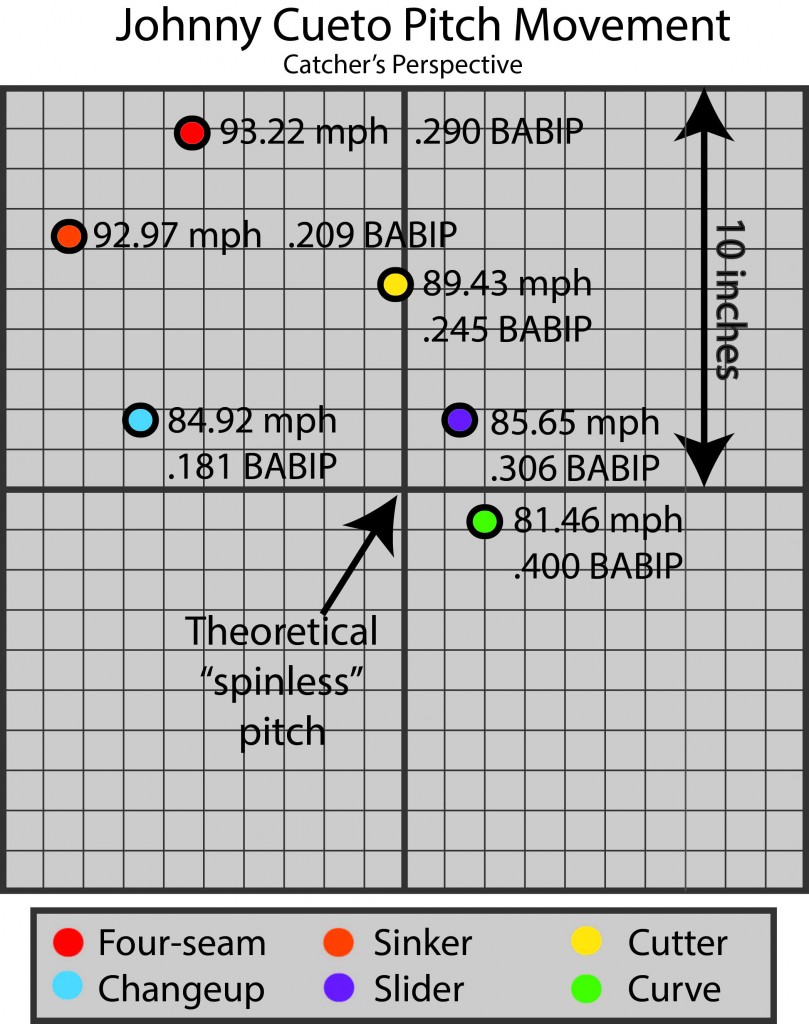Johnny Cueto: If You Can’t Make Him, Buy Him?
If you could add any player to the D-backs without regard to feasibility, who would it be? I wondered that question out loud on Twitter on Saturday, and got a mixed bag of different kinds of responses. Among the pitchers named in response: Carlos Carrasco, Sonny Gray, Zack Greinke, Kenta Maeda, Clayton Kershaw, and Chris Sale. Among the pitchers not named in response: Johnny Cueto.
That’s probably where feasibility comes in. Kenta Maeda can happen, and it looked to us like there was room to add two pitchers in the $15M-$20M a year range — but only if one of them came on a short term deal. That’s why we liked Scott Kazmir for the Offseason Plan, since there’s a chance 2 years could happen (unlikely, but maybe with a vesting option), and there’s a solid chance that 3 years could happen. But oh how we worked to see if Carlos Carrasco could ever make sense (David Peralta is the sticking point there), and while we included a Sonny Gray trade, the chances that that could happen depend completely on whether or not Billy Beane sees Yasmany Tomas as a player worth buying.
Part of the point is: the Contention Window is 2, maybe 3 years large. And the aforementioned Tomas is a big part of that: although more money may be coming in and salaries may be higher by 2019 and 2020, the $32.5M total that Tomas may be due in those two seasons may end up being hard to work around, as the D-backs are only on the hook for that money if Tomas thinks he can’t improve on those figures (either in dollars or years) at the end of the 2018 season. With Paul Goldschmidt potentially a free agent after his 2019 option year and A.J. Pollock no longer adding value at a discount after 2018, the payroll crunch looming at the end of the Window could be crushing — and the farm system isn’t exactly bursting with high-ceiling, low-minors prospects who may arrive around that time.
All of that makes the D-backs’ pursuit of Johnny Cueto curious. On one hand, we know the D-backs couldn’t be more serious about contention within this Contention Window, and Cueto may be the best pitcher they could afford right now. On the other, he may not be so good that when added to the Tomas commitment and a likely play for Maeda, one would be comfortable betting the entire outcome of the Goldschmidt Era.
So why, then, did the D-backs make a 6 year, $120M offer to Cueto earlier this month, as reported by Steve Gilbert? Why does it sound like GM Dave Stewart would be willing to improve on that offer to land Cueto (depending on ownership’s decision on whether they “can go there”), per Nick Piecoro?
In some ways, Cueto is exactly who you’d think the front office might like. He can still throw hard; Brooks Baseball has a top release speed of 97.27 mph for Cueto last season, which is pretty great for a 29-year-old. And it seemed a year ago that the D-backs were hoping to rebuild their staff in Dave Stewart‘s image, training pitchers with big fastballs to make The Leap from MLB quality to front-of-the-rotation quality.
Cueto started his career getting more strikeouts, but otherwise not missing barrels or pitching efficiently:
Cueto’s record is very good, and it shows steady improvement, up until last season. He really broke through, though, in a shortened 2011, the first year in which he became much harder to hit. He’s pitched like an ace in terms of results for most of the last five seasons. In the table above, I colored in just the middle five columns — the ones with rate stats. But take a look at how his record looks a little different when I turn everything into rate stats:
Cueto’s efficiency improved in 2010 somewhat, but the real change was from 2010 to 2011. Last year, the average start lasted 5.81 innings; Cueto has bested that with plenty of room to spare now for five seasons running, except for when he was working his way back from injury in 2013. That increased efficiency is part of why it looked like Cueto’s strikeout and walk rates took a huge dive in 2011, per K/9 and BB/9 — once you use batters faced instead of innings to get K% and BB%, the dropoff looks nowhere near as significant.
You pay attention to the D-backs and you read this site at least occasionally, so something else stuck out to you here: ground ball percentage. Last season, Cueto’s batted profile was pedestrian, and his ground ball percentage (42.5%) was actually a bit lower than the average starter (45.2%). In Cueto’s best seasons, though — 2011, 2012 and 2014 — Cueto’s ground ball percentage was a fair bit higher than league average. You couldn’t really blame the D-backs if they saw this and said “we can fix this man, he will go back to being dominant in our ground ball system.” And maybe that’s true.
But from the perspective of an engaged observer, it looks like Cueto got to where he is by adhering to his own plan. To wit:
- He uses four different deliveries; after an October start, August Fagerstrom found that Cueto had used his “Quick Pitch” delivery 48% of the time, his “Tiant” 25% of the time, his “Traditional” delivery 20% of the time, and his “Rocking Chair” delivery 7% of the time (go to Fagerstrom’s piece for the GIFs).
- At least toward the end of the 2015 season, it looks like Cueto had purposefully taken a tick off of his fastball toward the beginning of his starts. Whether that was just to get through more innings, I have no idea; but in a piece earlier in October, Fagerstrom noted that from August 21 to October 4, his average fastball velocity the first time through the order was 91 mph, 92 mph the second time through, and 93 mph the third time through. As noted above, Cueto can still reach back and fire harder than that; no idea whether that was a purposeful attempt to borrow a bit from the early innings to make his fastballs harder to react to later in the game.
- In most starts, Cueto throws six different pitches: four-seam, sinker, cutter, change, slider and curve. It’s mostly a mix of the three fastballs, but though the four-seam has a slight edge, you don’t really know what you’re going to get — and the movement difference is enough to make the guessing game turn into bad contact.
Cueto’s stuff flattened out a bit in 2015, especially at the end of the season, and especially with respect to his changeup, as Eno Sarris explored in embarrassing (to other writers) detail. But to get an idea of Cueto’s ace-level junk-baller-ness, here is the average movement on his six pitches in 2014 from Brooks Baseball, along with average velocity and BABIP for each pitch:
What the D-backs may get in Cueto is exactly what they were hoping to get in Rubby De La Rosa. Unlike RDLR, though, Cueto managed to do it, and he did it consistently. He did it mostly in a notoriously homer-friendly bandbox in Great American Ballpark, something that also checks a box on the D-backs’ shopping checklist. It also doesn’t hurt that Cueto has been able to do something much, much more valuable than what Bronson Arroyo did in avoiding the DL so long: soak up major innings when in the rotation. That 243.2 innings mark in 2014 led the NL.
Maybe the team can’t have a Kershaw or a Sale, a pitcher that makes his own luck by striking out enough batters to not need any luck. If the cupboard is bare of those kinds of starters, though, the D-backs could do a lot worse than picking up a pitcher who has shown himself capable of managing contact so well. Over the last five seasons, Cueto has held batters to a .269 BABIP — third best among all starters with at least 500 IP in that span, just behind Jared Weaver and Matt Cain and just ahead of R.A. Dickey and Clayton Kershaw.
There’s no starting pitcher who offers guarantees, and for the D-backs, an injury to a $20M+ man would obviously hurt the team’s chances of staying in the race. If the team were to go six years on a starting pitcher entering his 30s, though, maybe it could do far worse than spend money on a pitcher who might, at worst, pitch like an Arroyo type at the end of his career. Missing barrels does seem to age better than missing bats, although there’s hefty survivor bias in drawing conclusions from pools of late-30s pitchers.
Cueto has managed to pitch like an ace without “ace stuff” — and a pitcher who can fix himself is particularly welcome in Arizona. It seems like it would be fair to say that Cueto has made the most of his talent, something you’d rather not pay for if you don’t have to, but something worth at least as much or more than doing well the Nuke LaLoosh way. It would have been great if RDLR or Allen Webster or Randall Delgado or Yoan Lopez or even Mike Bolsinger could have gotten more out of their talents in Sedona Red. But the Contention Window is here, and that means imperfect bets can still be great moves.
6 Responses to Johnny Cueto: If You Can’t Make Him, Buy Him?
Leave a Reply Cancel reply
Recent Posts
@ryanpmorrison
 Congrats to @OutfieldGrass24 on a beautiful life, wedding and wife. He deserves all of it (they both do). And I cou… https://t.co/JzJtQ7TgdJ, Jul 23
Congrats to @OutfieldGrass24 on a beautiful life, wedding and wife. He deserves all of it (they both do). And I cou… https://t.co/JzJtQ7TgdJ, Jul 23 Best part of Peralta’s 108 mph fliner over the fence, IMHO: that he got that much leverage despite scooping it out… https://t.co/ivBrl76adF, Apr 08
Best part of Peralta’s 108 mph fliner over the fence, IMHO: that he got that much leverage despite scooping it out… https://t.co/ivBrl76adF, Apr 08 RT @OutfieldGrass24: If you're bored of watching Patrick Corbin get dudes out, you can check out my latest for @TheAthleticAZ. https://t.co/k1DymgY7zO, Apr 04
RT @OutfieldGrass24: If you're bored of watching Patrick Corbin get dudes out, you can check out my latest for @TheAthleticAZ. https://t.co/k1DymgY7zO, Apr 04 Of course, they may have overtaken the league lead for outs on the bases just now, also...
But in 2017, Arizona ha… https://t.co/38MBrr2D4b, Apr 04
Of course, they may have overtaken the league lead for outs on the bases just now, also...
But in 2017, Arizona ha… https://t.co/38MBrr2D4b, Apr 04 Prior to the games today, there had only been 5 steals of 3rd this season (and no CS) in the National League. The… https://t.co/gVVL84vPQ5, Apr 04
Prior to the games today, there had only been 5 steals of 3rd this season (and no CS) in the National League. The… https://t.co/gVVL84vPQ5, Apr 04
Powered by: Web Designers@outfieldgrass24
 Starting 2022 with a frigid dog walk sounds just lovely https://t.co/xoLZSZBpGp, 10 hours ago
Starting 2022 with a frigid dog walk sounds just lovely https://t.co/xoLZSZBpGp, 10 hours ago I’ll never forget seeing Kyle Seager at the Scottsdale Fashion Square one March with his family and thinking “damn,… https://t.co/uapNYdsU2a, Dec 30
I’ll never forget seeing Kyle Seager at the Scottsdale Fashion Square one March with his family and thinking “damn,… https://t.co/uapNYdsU2a, Dec 30 Big dogs. Bigger trees. @ Avenue of the Giants, Nor Cal https://t.co/YAdxcE1t1p, Dec 29
Big dogs. Bigger trees. @ Avenue of the Giants, Nor Cal https://t.co/YAdxcE1t1p, Dec 29 Old friend alert https://t.co/7HQjiyBWTB, Dec 27
Old friend alert https://t.co/7HQjiyBWTB, Dec 27 Death wish https://t.co/XJzcMkNPTy, Dec 26
Death wish https://t.co/XJzcMkNPTy, Dec 26
Powered by: Web Designers








Derrick Hall, Tony La Russa, and Dave Stewart all made the trip to the Dominican Republic to meet with Johnny Cueto after meeting his agent at Chase Field. I have to believe the intent was to project seriousness. As for the offer, it was in the ballpark but certainly not their final offer.
As news editors are fond of saying…developing.
As a fan, I truly appreciate management going after Cueto. It’s gutsy and risky, yet encouraging to see a contention window opening and management stepping up to embrace it. But I think there is a limit, now that Cueto has rejected the largest offer, to how much the D’backs can up the offer, before they price them selves out of a second quality starter. The rotation needs two, not just one, significant upgrade to contend.
At 6/120 the team is already out of the market on a second truly quality arm that can eat a substantial chunk of innings. The best they could hope for at that point is to find a somewhat safe buy-low candidate like Fister or Latos and hope for a dead cat bounce.
The team would look much better with two starters added to the mix. However, since the team seems dead-set on using RDLR as a starter again in 2016 for some reason, they only have room to add one. Even that still pushes Blair back to Reno again, despite the fact that Blair, without having thrown a single MLB pitch, might be the second or third best starter on the staff if they started today.
A couple of observations if I may. One of Cueto’s strong points is that the last few years he has shown an ability to go deep into games. At the same time, he has gotten tired late in the season and been less effective. One of the reasons for his going deeper in games was the horrible bullpen in Cincy. I can’t tell you how many games they blew for him, trying to bridge the gap between Johnny an Aroldis. But rest assured, it was a lot. To save himself aggravation, Cueto often stayed in the game when maybe he shouldn’t have. Fatigue sets in, hits happen, the ball stays up in the zone, and those ground balls become less frequent. With a much better bullpen in Az than in Cincy, he might be exactly what we need. His familiarity with NL hitters would also be a plus. The fatigue, the unfamiliarity with AL hitters, and his own reputation for staying in the game, I think, hurt him in KC. I hope we can find the extra funds to sign him, or maybe other teams will be scared off by his KC experience. Come on Johnny !!
With Price coming off the board, the Dbacks need Cueto in a big way. Go ahead and throw in whatever it takes. With the current contention window, and the weak free agent pitching class next offseason, the Dbacks cannot afford to lose a free agent ace over 10 or 20 million, especially when they have the lowest payroll in all of major league baseball. Its time for the owners to step up to the table! Like Ive said before, its not about quantity as much as its about quality. With so many people being insistant that the dbacks walk away with 2 pitchers from the free agent market, I would much rather they walk away with one ace rather than 2 #2 or #3 starters when they already have a plethora of them waiting in the wings.
[…] often see a BABIP more than 10 or 15 points off of the league average (Johnny Cueto being one of the biggest exceptions), which tends to be within a couple points of .300. It may be that Kazmir really was lucky; SIERA […]